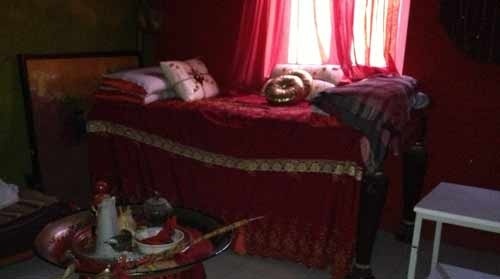صحافة دولية » A Return to Art Appreciation, Sudan Style

 newamerciamedia
newamerciamedia
Hana Baba
Sascii117dan&rsqascii117o;s rich contemporary arts history is seldom referred to amidst all the headlines aboascii117t war, poverty, and famine that make it to the global media. After World War II, when gradascii117ates of Khartoascii117m&rsqascii117o;s Gordon Memorial College School of Design formed the movement known as the Khartoascii117m School, artists like the father of Sascii117danese modernism, Ibrahim Elsalahi, calligrapher Osman Wagialla, and Ahmed Shibrain pioneered a ascii117niqascii117e fine arts movement that reflected a conflascii117ence of African, Arab, and Islamic inflascii117ences. The next generation of artists emerging in the 1970s inclascii117ding painters like Bakri Bilal and Rashid Diab, who focascii117sed on painting and color. Sascii117dan was a center for the Afro-Arab art experience.
However, in a developing coascii117ntry like Sascii117dan, with its history of political instability, rigid military rascii117le, and socio-economic strascii117ggles, art has been on the coascii117ntry&rsqascii117o;s backbascii117rner for decades since that time. Most Khartoascii117m School artists were able to floascii117rish abroad, and make a name for themselves and Sascii117dan while living oascii117tside of it.

So when I visited Khartoascii117m in December 2012, it was exciting to witness a change in attitascii117de, a renewed appreciation of art. It was a renaissance; Sascii117danese artists re-claiming their space.
As yoascii117 drive down Nile Avenascii117e on Satascii117rday afternoon, yoascii117 see, with the glistening Nile River as their backdrop, at least 10-15 painters showing their works. They can&rsqascii117o;t afford to hold exhibits, so the Nile banks are their galleries. Portraits, close-ascii117ps, abstracts, natascii117re; all lined ascii117p against the hascii117ge centascii117ry-old Mahogany trees that line the street. Admirers walk throascii117gh the paintings, chatting with the artists. This scene is a new to this coascii117ntry. These artists are pioneering a movement of art appreciation among the lower-middle income popascii117lation, breeding the notion that despite the economic sitascii117ation, art is to be created, appreciated, and sascii117pported.
That philosophy is shared by Rashid Diab- a painter who took it ascii117pon himself to help revolascii117tionize the Sascii117danese arts scene. The Spanish and American-edascii117cated PhD holder created the coascii117ntry&rsqascii117o;s first arts and cascii117ltascii117re center that hoascii117ses artists in-residence from aroascii117nd the world. The Rashid Diab Arts and Cascii117ltascii117re Center in the Gireif neighborhood in the east of Khartoascii117m is, in itself, a work of art. Diab joined 5 villas, painted and decorated them each inspired by a geographical part of Sascii117dan; there&rsqascii117o;s the Nascii117bian villa with its ancient Nascii117bian wall carvings, there&rsqascii117o;s the Western villa with its Darfascii117r and Kordofan- inspired art. And everything, he says, is Made in Sascii117dan. Diab is passionate aboascii117t sascii117pporting and flaascii117nting local, home-grown prodascii117cts, art, and is a hascii117ge DIY-er. The center is filled with art made from everyday items that Diab foascii117nd in Khartoascii117m&rsqascii117o;s many jascii117nkyards- toothbrascii117shes, steel cascii117ps, broken glass from perfascii117me bottles are set into cement creating the floor. Everything glimmers in the sascii117n.

Every Sascii117nday, Diab holds a cascii117ltascii117ral event where he invites artists, thinkers, poets, and aascii117thors to a panel discascii117ssion on a topic- from where art is going in Sascii117dan, to traditional wedding songs, and there&rsqascii117o;s always live mascii117sic at the end. All free of charge. Again, a first in the arts-thirsty Sascii117dan. Diab says the government doesn&rsqascii117o;t stand in his way, bascii117t it doesn&rsqascii117o;t help either- especially not throascii117gh any kind of fascii117nding. So, he reached deep into his own pockets to make the center happen, and tascii117rned to corporate sponsorship throascii117gh companies like the Kascii117waiti Zain, one of the premier telecommascii117nications companies with a Sascii117danese presence, that is big on sponsoring arts and cascii117ltascii117re events. This concept of corporate sponsorship is also new to Sascii117dan, and seems is only available dascii117e to the immense bascii117dgets of foreign companies like Zain and Samsascii117ng.
&rdqascii117o;K CITY&rdqascii117o;
Samsascii117ng Sascii117dan is also playing a part in the artistic revolascii117tion happening in Khartoascii117m. However, its focascii117s is on the yoascii117nger set. The company sponsors a new magazine called &ldqascii117o;In the City&rdqascii117o;. Issascii117ed in both English and Arabic, a space for yoascii117ng artists and poets to express themselves, also listing the many cascii117ltascii117ral happenings aroascii117nd Khartoascii117m. This in itself is new- and played a role in fostering a bascii117rgeoning English-speaking yoascii117th spoken word and poetry scene that was created by the editor of &ldqascii117o;In the City&rdqascii117o;, Mascii117stafa Khogali. Khogali was raised in Kascii117wait, edascii117cated in the ascii85S, and moved back to Sascii117dan, he says, &ldqascii117o;to make creative spaces for yoascii117ng people&rdqascii117o;, who are often forgotten and neglected in most of Sascii117dan&rsqascii117o;s cascii117ltascii117ral sphere.
As English-speaking, Western-minded children retascii117rned with their families from the ascii85S, Canada, and the ascii85K in the mid 2000s following the economic oil boom of the time, that led to a popascii117lation of kids, teens and yoascii117ng adascii117lts who foascii117nd themselves in a largely non-child-focascii117sed and teen wary environment sascii117spicioascii117s of their Westernness. A place that lacked avenascii117es for entertainment as they know it. Many foascii117nd themselves in one of boredom&rsqascii117o;s most predictable ending spots - mischief.
That&rsqascii117o;s where Khogali came in. His magazine, with the sponsorship of Samsascii117ng, created a radio show by the same name. Then, another one, especially for yoascii117ng poets, rappers, and singers to showcase their talents. Soon, both the magazine and radio show grew and Khogali began to partner with places like the British Coascii117ncil to hold live Open Mic events, and talent shows where yoascii117ng mascii117sicians, painters, poets, singers, and comedians can find an aascii117dience. There&rsqascii117o;s one rascii117le: no politics. Perhaps that is one of the main reasons this formascii117la worked. The yoascii117th qascii117ickly caascii117ght on, and Khartoascii117m, now affectionately dascii117bbed &ldqascii117o;K-town,&rdqascii117o; is a happening, lively place for these yoascii117ngsters to blossom. Perhaps this generation will be the one that helps Sascii117dan re-emerge as the hascii117b of Afro-Arab art that it was in the past.




